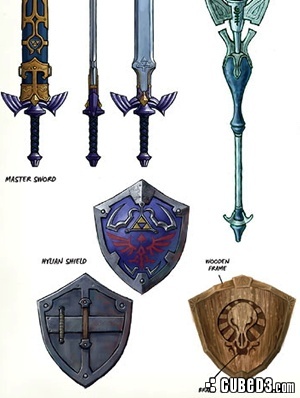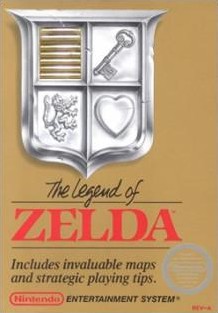 There are so many questions about The Legend of Zelda that fans would ask if they could have afternoon tea with Nintendo. The answers come in the form of the 276 page Hyrule Historia.
There are so many questions about The Legend of Zelda that fans would ask if they could have afternoon tea with Nintendo. The answers come in the form of the 276 page Hyrule Historia.
There's something incredibly special about The Legend of Zelda that remains untouched by similar adventure games and sword-wielding settings. The cast of unforgettable characters, locations, items and dungeons have cemented themselves in every hero's mind as stories that demand being replayed even after the final credits roll.
If you're a Legend of Zelda veteran who can name all the Kokiri children in alphabetical order, tackle Ocarina of Time's water temple blindfolded and dress like the Hylian hero or are a series newbie, there questions that remain unanswered. Where do the games fit in the quarter-of-a-century timeline? What is the inspiration for Ganondorf? Do we play as the same "Link" in each Legend of Zelda incarnation?
 Until now Nintendo have been very selective on the chronology and why key elements have been designed in the way they have. Bits and pieces have been unravelled through meticulously picking apart games, looking at unused codes and collating quotes from interviews with series producers. After a quarter of a century the team behind The Legend of Zelda - lead by Shigeru Miyamoto and Eiji Aonuma - have shared secrets on how these critically acclaimed games came to be, how they all slot together, plus what ended up on the chopping board.
Until now Nintendo have been very selective on the chronology and why key elements have been designed in the way they have. Bits and pieces have been unravelled through meticulously picking apart games, looking at unused codes and collating quotes from interviews with series producers. After a quarter of a century the team behind The Legend of Zelda - lead by Shigeru Miyamoto and Eiji Aonuma - have shared secrets on how these critically acclaimed games came to be, how they all slot together, plus what ended up on the chopping board.
Hyrule Historia is a fitting tribute to an iconic series that continues to redefine fantasy adventure worlds and games.
The book was originally released in Japan in 2011 with an official English version only announced months later. It was an extreme tease for any Legend of Zelda fan as images of the book's stunning artwork started to trickle online. Dedicated groups had even embarked on a difficult but rewarding challenge: translate all of the 276 pages into various languages. But fortunately publisher Dark House, joined by a handful of Legend of Zelda enthusiasts, picked up the project and has done a stellar job converting Nintendo's words from Japanese.
 Hyrule Historia is divided up into three distinct sections: a sixty page feature outlining the world's creation, a further chapter that describes the entire timeline so far and a wealth of design documents from twenty five years of development. Each page offers tiny morsels of insight into the often bizarre designs, from the subtle elements to the bigger picture. In one corner there are details on if a character has bruised fingers, how he wears his hat or how she holds a cup, and in the other temple designs and overworld mechanics. It illustrates a level of thought and care that may not be apparent when playing through a Legend of Zelda game; the basics of talking to a village resident or browsing a shop for example.
Hyrule Historia is divided up into three distinct sections: a sixty page feature outlining the world's creation, a further chapter that describes the entire timeline so far and a wealth of design documents from twenty five years of development. Each page offers tiny morsels of insight into the often bizarre designs, from the subtle elements to the bigger picture. In one corner there are details on if a character has bruised fingers, how he wears his hat or how she holds a cup, and in the other temple designs and overworld mechanics. It illustrates a level of thought and care that may not be apparent when playing through a Legend of Zelda game; the basics of talking to a village resident or browsing a shop for example.
Beyond the vast fundamentals behind Skyward Sword is the eagerly anticipated History of Hyrule; a dedicated and comprehensive breakdown of what fans have been stitching together for many years. This chapter shuffles the Legend of Zelda catalogue into a conceivable timeline that begins from Skyward Sword and after the events of Ocarina of Time branches out into further timelines based on three outcomes - If Link is defeated, when he returns to his own timeline and the world without a hero. There are still questions to be raised about Nintendo's ideas behind time travel but that's a story for another day! This segment in itself is a thorough enough story to form a separate book in its own right, but of course may be best left until completing a fair few of the games as it of course doesn't hold back on potential spoilers.
 The final chunk contains a wealth of new design drawings, concept designs for the entire catalogue of Legend of Zelda titles (with the exception of those shunned Phillips CD-I spin-off TV games). The sketches and painted pieces also touch on unused monsters, some more goblin-like than ever before, plus locations and dungeons not included in the end products. Twilight Princess is a particularly strong highlight, weaving a far darker and deeply sinister mood amongst Link's chirpier adventures.
The final chunk contains a wealth of new design drawings, concept designs for the entire catalogue of Legend of Zelda titles (with the exception of those shunned Phillips CD-I spin-off TV games). The sketches and painted pieces also touch on unused monsters, some more goblin-like than ever before, plus locations and dungeons not included in the end products. Twilight Princess is a particularly strong highlight, weaving a far darker and deeply sinister mood amongst Link's chirpier adventures.
More recent games like Spirit Tracks, Twilight Princess and Wind Waker are explored in far more detail than other series staples. It is odd how the games considered being in the top give at least - Ocarina of Time and Majora's Mask - barely get a mention in the book, whilst the brilliant Game Boy adventure Link's Awakening receives just a single side with a handful of design crumbs.
With over two hundred pages worth of content it is difficult justifying disappointment, but there is a desire to see more development drawings and concepts from the older Legend of Zelda games that were only brushed upon in Hyrule Historia.
 Whilst a delectable treat to explore something new on each page, it is disappointing that the balance of games isn't quite there in this chapter in particular. Details on the range of masks in Majora's Mask, inspiration for the world of Termina, location designs for Ocarina of Time are just the tip of the iceberg of content that should have been explored in some form. For example the section spanning Spirit Tracks is almost three times longer than the design docs for both classic Nintendo 64 games combined. It's an odd decision given the franchise's heritage.
Whilst a delectable treat to explore something new on each page, it is disappointing that the balance of games isn't quite there in this chapter in particular. Details on the range of masks in Majora's Mask, inspiration for the world of Termina, location designs for Ocarina of Time are just the tip of the iceberg of content that should have been explored in some form. For example the section spanning Spirit Tracks is almost three times longer than the design docs for both classic Nintendo 64 games combined. It's an odd decision given the franchise's heritage.
If three meaty chapters of history weren't enough, series manga artist Akira Himekawa included a prequel to Skyward Sword in a short manga form that offers some insight into how the historical battle of demons and power came to be at the very beginning - a gritty, action packed conclusion ending in a rather emotional way for our hero.
[score=9]Hyrule Historia is a masterpiece of Nintendo design, collating years of unparalleled experiences with a cast of memorable friends and foes into the definitive encyclopedia of all things The Legend of Zelda. It comes highly recommended for a know-it-all fan or a series newcomer; there's plenty of insight and revelation into what had initially started off as a "simple dungeon building game for two players". If there's any video game merchandise on your wishlist, make space on your desk for Hyrule Historia.

 Sign In
Sign In 30.01.2013
30.01.2013  Game Details
Game Details
 Out now
Out now  Out now
Out now  Out now
Out now  Out now
Out now 
 Link to this post:
Link to this post:  jb
jb  Subscribe to this topic
Subscribe to this topic Features
Features







 Top
Top

